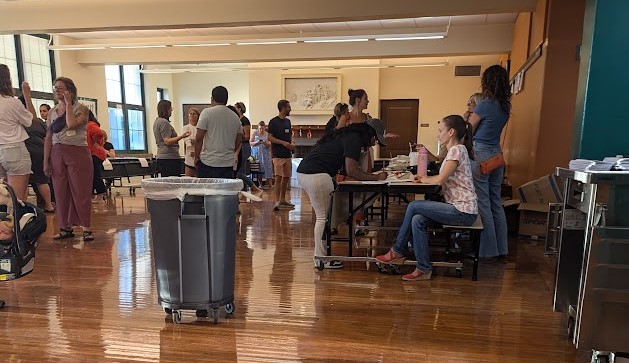As I walked into the halls of Clinton Elementary, 25 minutes before the PTA meeting start time, I could not help but feel transported back into my own elementary school. The weird feeling of being there after hours still resonated, and the faint smell of dry cafeteria milk lingered. The similarities soon faded after seeing how prepared the PTA meeting was – very much unlike the ones my Mom went to. I was shocked by the preparations for the first meeting of the year: cookies, nametags, sticky notes, projector set-up already working, committee tables, an agenda and even a microphone. The atmosphere of the cafeteria was hopeful and excited, bustling with new year energy. The walls were lined with the same clipart, reminding children to keep their noise levels down, as was in my own elementary school. As parents walked in, they gathered near familiar faces or waited anxiously for their “dad posse,” as one dad so eloquently stated. Voices filled the air as several parents stated that they, “couldn’t remember how old the kids are anymore,” and that “everyone is getting so old!” Even the quiet parents could not escape the small talks of the PTA committee; they made sure to say hello to everyone in attempts for community building.
After the chat session of the meeting ended, the fun logistical discussion started. This is where I learned a lot of the general interests the PTA holds. Continuously, the speakers talked about building “community” between parents, children, and even between grade levels. One example was having all 3rd graders come to the playground to bond the classes even more. They also had events planned like the international week and other fundraisers that could activate people in the community’s attention.
Another common theme was easing the stress and need on parents. They continuously brought up that they acknowledged that parents’ time is valuable and they want to make it easy to volunteer time and make it feel worthwhile doing so. Even the meeting was structured to end exactly at 8:00pm to avoid any staying late. They addressed wording concerns in trying to get volunteers, saying that “co-leading is less stressful” than fully leading a project. Their goal in fundraising was less time commitments but more variety in what they need help with. Another way of easing the time burden is by putting more money into projects to require less labor. By being realistic about expectations for volunteers and time requirements, they felt more genuine and easy to approach.
Finally, the third main topic was being there for the children. All of this work is for the kids. This school receives less funding than other schools in the area, so parents being active in the community means a better experience for their children. They provide resources to students in need. They are also an enrichment super stretch school, meaning that if a student is behind, this school is able to improve them exponentially over a set period of time. The president is matching money raised to buying more technology for the classrooms than can help with various needs and learning methods. Even caring as to directly speak out against certain fundraising methods, dismissing the act of “outsourcing kids for money.” Think of the door to door calendar buying of the 2010s.
REVIEW
This experience was incredibly important to me. Not only did it give me access to people that would later send my survey out, but it also let me know how parents were feeling about their involvement and general responsibilities surrounding school, life, and their kids. I was greatly surprised by the amount of effort put into making the parents feel less stressed and more valued. This is in high contrast to my assumptions of PTA members, which was that parents almost socially guilt each other into signing up for more and more responsibilities. While that could still be happening, it was not coming from the leadership team. I think the three main topics that they covered, being community, care, and connecting to parents, are all very important for me to continue thinking about. These are the active parents of a community, who love being part of their children’s lives and are able to spend time outside of their schedules to do so. What are their needs? This perspective will be crucial further on in my capstone, and I again am so happy I went, even if I got a few weird stares for being on the younger side!




